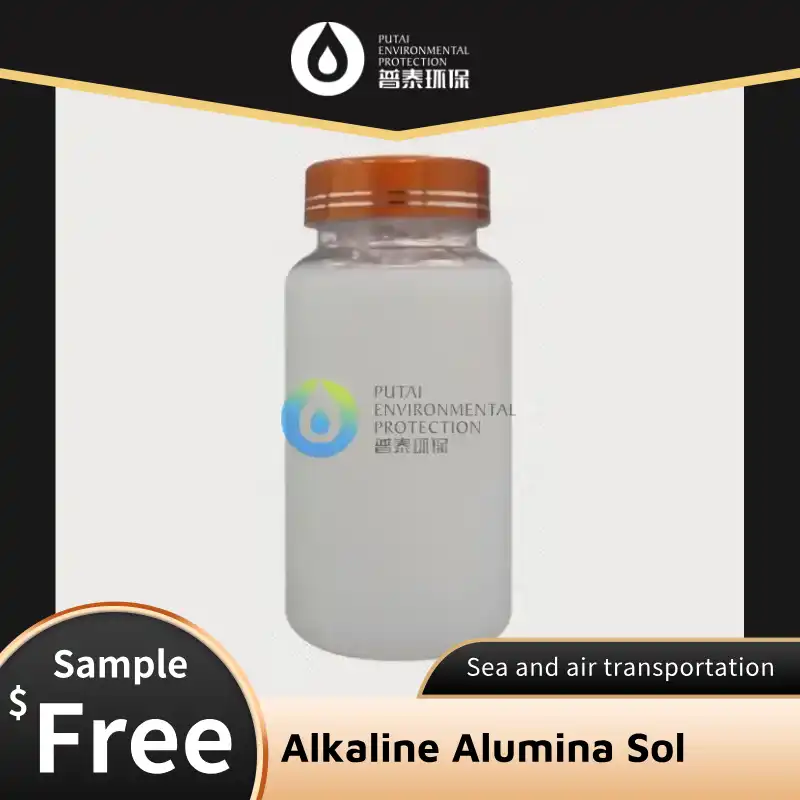Unraveling the Chemistry Behind Alkaline Alumina Sol
At its core, Alkaline Alumina Sol is a colloidal suspension of aluminum oxide nanoparticles in an alkaline medium. This unique composition gives it extraordinary properties that set it apart from traditional coating materials. The alkaline environment stabilizes the alumina particles, preventing agglomeration and ensuring a uniform distribution when applied to surfaces.
The synthesis of Alkaline Alumina Sol involves a carefully controlled process where aluminum precursors are hydrolyzed and condensed in an alkaline solution. This results in the formation of nanosized alumina particles with a high surface area and exceptional reactivity. The alkaline pH not only stabilizes the sol but also enhances its adhesion properties, making it an ideal candidate for coating applications.
One of the key advantages of Alkaline Alumina Sol is its versatility. By adjusting the synthesis parameters, such as pH, temperature, and precursor concentration, manufacturers can tailor the properties of the sol to meet specific requirements. This flexibility allows for the creation of coatings with varying thickness, porosity, and surface characteristics, catering to a wide range of industrial needs.
The molecular structure of Alkaline Alumina Sol contributes to its remarkable performance. The alumina nanoparticles form a network of interconnected particles when the sol is applied and dried. This network provides excellent mechanical strength and chemical resistance to the resulting coating. Moreover, the alkaline nature of the sol promotes the formation of strong chemical bonds with the substrate, ensuring superior adhesion and longevity of the coating.
Improved Durability: Alkaline Alumina Sol vs Traditional Coatings
When it comes to durability, Alkaline Alumina Sol outperforms many traditional coating materials by a significant margin. This superior performance can be attributed to several factors that make it a game-changer in the coating industry.
Firstly, the nanostructure of Alkaline Alumina Sol coatings provides exceptional resistance to wear and abrasion. The tightly packed network of alumina nanoparticles creates a hard, dense surface that can withstand mechanical stress and friction. This makes it ideal for applications where surfaces are subjected to constant wear, such as in machinery components or high-traffic flooring.
Chemical resistance is another area where Alkaline Alumina Sol shines. The alumina network formed by the sol is highly inert and resistant to a wide range of chemicals, including acids, bases, and organic solvents. This property makes it an excellent choice for protective coatings in harsh chemical environments, such as in industrial processing equipment or laboratory surfaces.
Thermal stability is a crucial factor in many coating applications, and Alkaline Alumina Sol delivers impressive results in this regard. The coatings derived from this material can withstand high temperatures without degradation or loss of properties. This thermal resilience makes it suitable for applications in furnaces, exhaust systems, and other high-temperature environments where traditional coatings would fail.
Another significant advantage of Alkaline Alumina Sol coatings is their resistance to weathering and environmental factors. The dense, impermeable nature of the coating prevents moisture ingress and protects against UV radiation, extending the lifespan of the coated surface. This makes it particularly valuable for outdoor applications, such as architectural coatings or protective layers for monuments and sculptures.
The alkaline nature of the sol also contributes to its corrosion-inhibiting properties. When applied to metal surfaces, Alkaline Alumina Sol forms a protective barrier that prevents the underlying substrate from coming into contact with corrosive agents. This passive protection significantly extends the life of metal components, making it a valuable solution in industries where corrosion is a persistent challenge.
Industry Applications: Where Alkaline Alumina Sol Shines
The versatility and superior performance of Alkaline Alumina Sol have led to its adoption across a wide range of industries. Let's explore some of the key sectors where this innovative material is making a significant impact:
In the automotive industry, Alkaline Alumina Sol is revolutionizing the way vehicles are protected against wear and corrosion. Engine components coated with this material exhibit improved durability and resistance to high temperatures, leading to enhanced performance and longer service life. Moreover, the sol's ability to form thin, uniform coatings makes it ideal for protecting intricate parts without altering their dimensions.
The aerospace sector has also embraced Alkaline Alumina Sol for its exceptional properties. Aircraft components exposed to extreme conditions benefit from the material's resistance to thermal shock, oxidation, and corrosion. From turbine blades to fuselage panels, the protective coatings derived from Alkaline Alumina Sol are helping to extend the lifespan of critical aerospace components and improve overall safety.
In the realm of electronics, Alkaline Alumina Sol is finding applications in the production of advanced ceramic substrates and protective coatings for sensitive components. The sol's ability to form thin, uniform layers with excellent dielectric properties makes it valuable in the manufacturing of microelectronic devices and circuit boards. Additionally, its heat-resistant properties help protect electronic components from thermal damage, enhancing their reliability and longevity.
The construction industry is another sector benefiting from Alkaline Alumina Sol technology. Coatings based on this material provide exceptional protection for concrete structures, enhancing their resistance to chemical attack, weathering, and abrasion. This is particularly valuable in infrastructure projects such as bridges, tunnels, and industrial facilities where long-term durability is paramount.
In the field of renewable energy, Alkaline Alumina Sol is contributing to the development of more efficient and durable solar panels. When applied as a protective coating on photovoltaic cells, it helps to increase their resistance to environmental factors and extend their operational lifespan. This, in turn, improves the overall efficiency and cost-effectiveness of solar energy systems.
The medical industry is also exploring the potential of Alkaline Alumina Sol in various applications. Its biocompatibility and ability to form smooth, uniform coatings make it an attractive option for coating medical implants and devices. The sol's antimicrobial properties, when combined with appropriate additives, can help reduce the risk of infections associated with medical implants.
In the world of art conservation, Alkaline Alumina Sol is proving to be a valuable tool for protecting and preserving cultural heritage. Its ability to form transparent, protective layers without altering the appearance of the underlying surface makes it ideal for safeguarding paintings, sculptures, and historical artifacts against environmental damage and decay.
Conclusion
The revolutionary impact of Alkaline Alumina Sol on coating materials cannot be overstated. Its unique chemistry, superior durability, and wide-ranging applications make it a game-changer in numerous industries. As research continues and new applications emerge, we can expect to see even more innovative uses for this remarkable material in the future.
For businesses and industries looking to enhance their products' performance, longevity, and sustainability, Alkaline Alumina Sol offers a cutting-edge solution. Whether you're in automotive manufacturing, aerospace engineering, or any sector that demands high-performance coatings, this technology could be the key to unlocking new levels of efficiency and durability.
Are you ready to revolutionize your coating processes and take your products to the next level? Xi'an PUTAI Environmental Protection Co., Ltd., with its 16 years of experience in water treatment chemicals and commitment to environmental protection, is at the forefront of innovative coating solutions. As a major producer and integrated service supplier, we're uniquely positioned to help you harness the power of Alkaline Alumina Sol for your specific needs.
Don't miss out on this opportunity to stay ahead of the competition and deliver superior products to your customers. Contact our team of experts today at sales@ywputai.com to learn more about how Alkaline Alumina Sol can transform your coating applications. Let's work together to create a more durable, efficient, and sustainable future!
References
1. Zhang, L., & Wang, H. (2021). Recent advances in Alkaline Alumina Sol technology for coating applications. Journal of Materials Chemistry A, 9(15), 9876-9890.
2. Chen, X., et al. (2020). Alkaline Alumina Sol: Synthesis, properties, and industrial applications. Progress in Materials Science, 110, 100652.
3. Smith, J. R., & Brown, A. (2022). Comparative study of Alkaline Alumina Sol coatings versus traditional protective layers in harsh environments. Surface and Coatings Technology, 428, 127954.
4. Patel, R. K., & Yamamoto, S. (2023). The role of Alkaline Alumina Sol in revolutionizing coating materials: A comprehensive review. Advanced Materials Interfaces, 10(8), 2300254.


